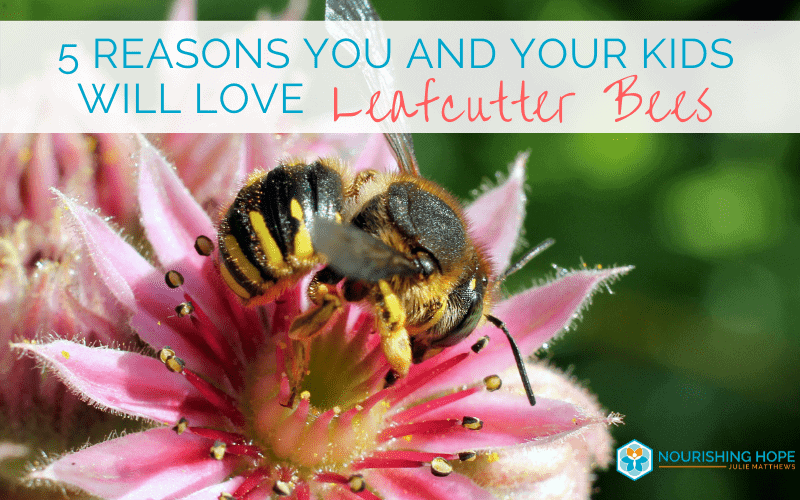
Bees!
Do they strike fear or joy?
I didn’t realize how much I love bees. It’s really a new affinity I have gained in recent years.
As I have gotten more and more into gardening, I have realized the importance of bees. I could have tons of tomato or squash flowers but if they don’t get pollinated by bees, they don’t produce fruit.
And when I heard about the decline of our bee populations (and the use of so many pesticides), I became more appreciative of bees.
But I didn’t really realize it.
It was actually my good friend, Terri Hirning, who gave me a mason bee house for my birthday that had me realize that I love bees.
You know how sometimes it takes a friend reflecting something back to you for you to notice. That’s what happened here. Apparently, I had been talking about them a lot and taking photos and videos (in slow motion).
I had never heard of a mason bee house. So I did some research.
Actually my house works for both mason bees and leafcutter bees.
Why Leafcutter and Mason Bees are Special
Mason bees are active in the early spring and pollinate fruit trees, and leafcutter bees are around late spring to summer and pollinate summer fruits and vegetables.
Mason bees and leafcutter bees do not produce honey.
But they do something else very special…
Leafcutter bees (and mason bees) have almost 100% pollination rates, compared with honey bees who’s pollination rate is around 3%. (Honey bees are wonderful too! Don’t get me wrong. I love them all.)
This means that virtually every flower a leafcutter bee lands in, it will pollinate.
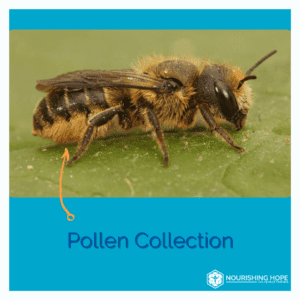 This is because of how different bees carry pollen. Honey bees carry pollen on a little structure (a type of “pollen basket”) on their hind legs, so there is not much loose pollen to spread from one flower to another. Leafcutter (and mason) bees, on the other hand, carry pollen on the hairs on their abdomen. As they go from one flower to another they easily pollinate each flower when the loose pollen falls from these hairs. I like to think of leafcutter bees as doing a belly flop onto each flower they encounter.
This is because of how different bees carry pollen. Honey bees carry pollen on a little structure (a type of “pollen basket”) on their hind legs, so there is not much loose pollen to spread from one flower to another. Leafcutter (and mason) bees, on the other hand, carry pollen on the hairs on their abdomen. As they go from one flower to another they easily pollinate each flower when the loose pollen falls from these hairs. I like to think of leafcutter bees as doing a belly flop onto each flower they encounter.
Mason bees and leafcutter bees are solitary bees. Each female is her own queen… in other words, she lays her own eggs. So there are no worker bees to guard the queen, and therefore they are not aggressive, and tend to be very gentle bees unless handled. And their sting is much more mild than a honey bee or wasp.
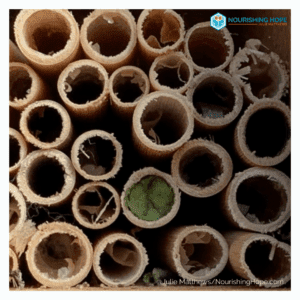
Mason bees use mud to lay eggs in long holes, tunnels, or reeds. Leafcutter bees cut out circles of leaves and make cocoons out of them. They also lay their eggs in tunnels. Although the size of the holes they prefer is a bit different. Notice the green cocoon the leafcutter bee made in our bee house.
As with other bees, they forage for pollen (protein) and nectar (sucrose and water) for food and to use for food for their eggs.
Why have leafcutter and mason bees?
5 Reason to Raise Leafcutter and Mason Bees
- Fun for Kids and Families
- Increase the Yield in Your Garden
- Good for Bees and the Earth
- Help Children Be Less Afraid of Bees
- Teach Science
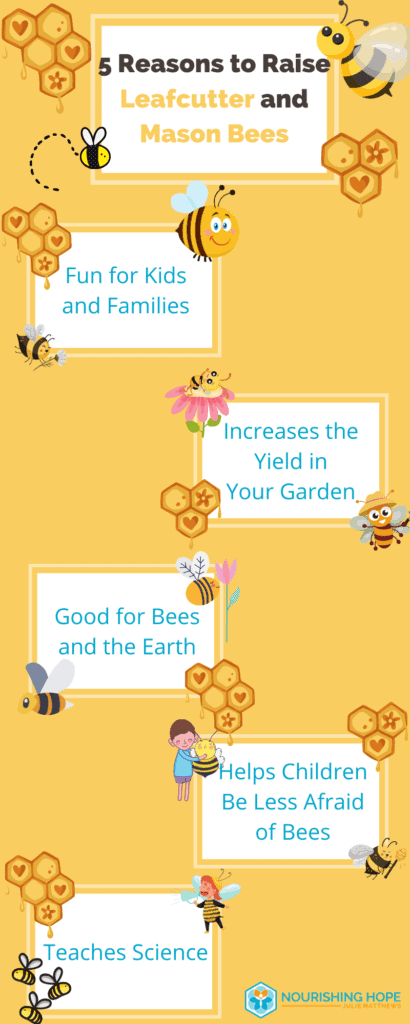
1. Fun for Kids and Families
It’s fun to set up the bee house and watch the bees emerge from cocoons. They crawl out of their hole and fly around doing their job of pollinating on day one. My daughter and I love to find them in the garden and watch them work. We get a kick out of seeing the leaves with a circle cut out, knowing they are hard at work laying more eggs. We also like to watch them come in and out of their nesting holes carrying leaves and going back out to forage for pollen and nectar.
2. Increase the Yield in Your Garden
Leafcutter and mason bees can significantly increase the yield of crops. Leafcutter bees were introduced in the United States in the 1930’s by alfalfa farmers for this very purpose. Many farmers have discovered mason bees after seeing the amazing yield of their neighbor or friend who had mason bees.
3. Good for Bees and the Earth
Our bees need all the help they can get. Between pesticides and colony collapse, the more we can take care of bees the better it is for ourselves, the bees, and our planet. Be a steward of nature. It’s fun and rewarding.
4. Help Children Be Less Afraid of Bees
Certainly, a healthy fear of bees is reasonable. And for those that are allergic to bees, I’m not suggesting getting solitary bees, or any bees for that matter.
With that said, having an irrational fear of bees isn’t helpful. The more calm we can be the better. My daughter has never been stung by a bee, but every time she was around them she panicked. Now, she loves bees. She is excited to watch them and be around them.
5. Teach Science
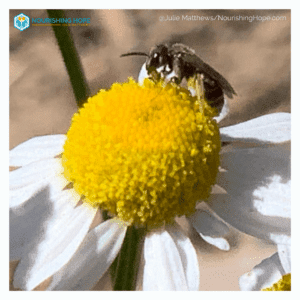
Bees are a great teaching opportunity. You can teach children about: pollen and nectar, pollination, flowers and fruit, the importance of pollinators, the types of flowers that attract bees the most, and how to protect bees.
It’s a fun experiment. I love science and kids learn most from hands-on experiences and opportunities to experiment. They will love having bees.
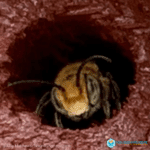
It’s also a great way to teach photography and videography. Here are photos from our garden. Our bees love our chamomile flowers. Notice the fluffy pollen on her tummy (notice she doesn’t have green eyes, and females have a more pointed abdomen).
See how this male has distinctive green eyes. He just emerged from his cocoon and is ready to launch.
How to Raise Mason and Leafcutter Bees
Supplies
- Bee house
- Nesting materials
- Bees
- Optional items: Bee pheromones
Setting up Your Bee House
Bee house
You can make or buy a bee house. Make sure your house has a depth of around 7 inches so that you have room for a roof and a place for bees to walk and stand.
I have two bee houses. One bee house I got from my good friend, that I mentioned above.
And here’s the other bee house I have.
You can also make a bee house or use a can to place tubes or reeds. Make sure your bee house has a roof and a bit of an overhang for rain.
Place your house so it’s facing the south or southeast so it gets morning sun. Bees are cold blooded so they need the warmth from the sun to fly. But find a location where their house can be shaded in the hot afternoon.
Nesting materials
Leafcutter bees are pretty tiny, and they nest in 6 mm holes. Mason bees need 8 mm holes. Wild bees are even smaller than leafcutter bees and use 4 mm nesting holes.
Tubes, reeds, or holes should be 6 inches in length to lay males and females.
There are three types of nesting materials (these are the ones for leafcutter bees, there are also different sizes for mason bees): Cardboard tubes, natural reeds, and wood drilled holes (split in half). Do not use bamboo nor holes drilled in solid wood. Next season’s bees in cocoons can’t get out, and will die. Bees tend to like natural reeds the best.
Bees:
Mason bees are active from Feb to May, and leafcutter bee season is May to September.
I really like Crown Bees to get your bees, house, and nesting materials.
Bee Pheromones
This is optional. It’s a spray that helps bees find their way to their new home. Spray it on the nesting materials. InvitaBee Plus+ is the brand I used.
Bee Building Materials
Make sure you have materials for them to build their home.
With leafcutter bees you’ll want plants they can use to make their cocoons. They like broad, flat, smooth leaves, such as rose leaves, lilac, or peas and beans.
Mason bees need mud. You can buy special mud for this purpose. You can also wet your own mud if you have the right native type.
Get Started Today
It’s easy to raise leafcutter bees.
You don’t need any special equipment such as a beekeeping suit or hive. You don’t need a smoker or care for the hive. You don’t need to know how to harvest honey or anything like that.
Almost anyone can raise leafcutter or mason bees.
It’s fun and is a great opportunity to explore nature with your kids. Get started today.




I love the bees and we have cutter bees all around our place. We also have Ponderosa Lemon Trees and they pollinate them wonderfully. However we also have a variety of roses and unfortunate the cutter bees love their leave to the point of cutting them almost bare of leaves. How do I stop this and yet keep my beautiful cutter bees active?
correction: That last sentence was “. . .I don’t know where OUR visitors reside”
LOL – shoulda proofread before hitting “Send.”
Hello Julie,
I loved your bee article and will keep it for reference! We have
a lot of fruit trees in our backyard, and I have watched the bee
population sadly diminish over the years. Happily, I see signs of
more bees recently.
As a child I was always afraid of getting stung by a bee. Then,
as an adult, I was stung by a wasp on my shoulder. I didn’t know
what stung me, and when I went into the house to see, a wasp flew
out! I immediately put Traumeel (homeopathic) on it, and there
was almost no swelling or pain – just a little red spot.
Now I’m not afraid of wasps either!
I have a question: Thanks to your article, I’m inspired to set up a
bee house at my home. Can the leafcutter and mason bees co-exist with
the bees already residing in our yard (I don’t have a hive–I don’t know
where are visitors reside)?
Hi Yvonne, you might LOVE mason bees then! They are great for fruit trees. Yes, mason bees and leaf cutter bees can co-exist. Wasps are not friends of either type of bees. But there are lots of varieties of wild bees, I think over 10,000 actually! And they are fine together. And thanks for sharing wasp/Traumeel experience.
Yes we need bees… at a distance… My son had a bee sting for the first time when he was 18 years old… and he went into anaphylactic shock. He phoned for an ambulance and was fortunately taken right to hospital for treatment. Now he always carries an Epi-pen.
Yes, Pat, I did mention that this is not a good option for people allergic to bees. I’m sorry to hear of your son’s experience. I’m glad he’s OK.